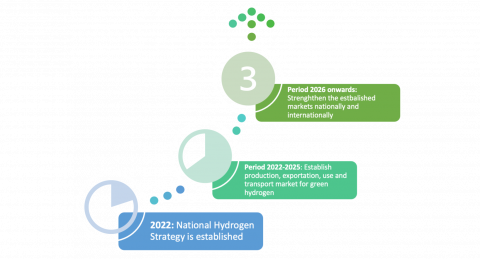Argentina
National Strategy
In June 2022, the Argentine government developed the 2030 National Low-Emission Hydrogen Strategy, in collaboration with the private and academic sectors, to promote public-private collaboration, investment in science and technology, and industrial participation, among other initiatives for the deployment of this energy vector.
In turn, this Strategy will be accompanied by a major update in its regulatory framework. The first Argentina regulatory framework was enacted in 2006, in other hydrogen environment. The country is pursuing the objective of 5 GW+ of electrolysis capacity by 2030. Although the strategy will contemplate hydrogen as a local energy vector, it will mainly favour green hydrogen exportation, for which Argentina has enormous potential.
The goal of the Strategy is allow to sequentially order the necessary measures to scale the H2 market. The regulatory framework will generate the benefits that lead to speeding up the production and consumption processes and will guide the country's efforts according to its competitive advantages.
Thus, production, transportation, storage and final use will be promoted according to the characteristics of national resources and dynamiting their rapid development. These measures are expected to allow the first projects into production by 2025.

Capacity and Price
- According to the government, Argentina can produce 1,000,000+ tonnes/year of green hydrogen by 2030.
- The Electrolyser capacity target is set at 5 GW+ by 2030.
Impact Targets
- The strategy for 2030 sets to drive the development that will generate 50,000 jobs.
- The green hydrogen economy in Argentina will be worth 15 billion in exports by 2050.
Policy Spotlight
- New regulatory framework. Argentina had its first hydrogen law in 2006. Today, the Ministry of Productive Development led by Matías Kulfas is designing a new regulatory framework in accordance with the transformations that the sector has undergone in the last 15 years. In this way, the aim is to deepen investments in the sector and value energy resources and technological capabilities.
- National Hydrogen Agency. Following the trends in public policies, the aim is to create a national agency that articulates and aligns the efforts behind the mission of developing the hydrogen economy, including the technological potentials and promoting the adoption of the energy vector in the Argentine economy.
- Fund for the Development of the National Hydrogen Industry. The new law also creates a fund to encourage the efforts of hydrogen supply and demand. In this way, actions can be taken to promote and accelerate the sectors defined as strategic for the country.
- Green Productive Development Plan. The world needs to move towards an ecological transition that effectively combats the problem of climate change and environmental degradation. Argentina developed a Green Productive Development Plan because it has much to contribute to this transition: renewable energies, technological equipment and capabilities, natural resources such as lithium and copper, as well as the ability to produce green hydrogen or electric vehicles, among other environmental solutions.
Financing
Productive investments committed for more than U$D 10 billion.
Green Hydrogen Vision
Argentina aims to be an important player in the production of green hydrogen, providing a solution to combat climate change and to build a sustainable future. In this way, the Country contributes to the energy transition by valuing its natural resources and its technological capabilities. In turn, the availability of green hydrogen will make possible to start decarbonizing the sectors with the most significant emissions: transportation, steel industry, fertilizers and oil refineries. In addition, Argentina seeks to reduce the carbon footprint of its energy matrix by replacing fossil fuels in the power generation sector, in part with green hydrogen. These objectives will position Argentina as one of the main hydrogen and its technology exporters in the Latin America region.
Green hydrogen opens a windows of opportunity for Argentina's development. The vast lands of Patagonia with the most suitable winds for wind generation, the availability of kilometres of coastline that give access to distant markets by sea shipment position our Country as a great investment destination for GH2. This is complemented by great possibilities in solar and hydraulic energy in the country. This will enhance the green hydrogen value chain and Argentina's energy supply security by creating green jobs. Therefore, Argentina has the necessary resources and capabilities to fulfil the role of regional leadership to which it aspires.
